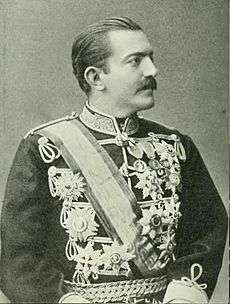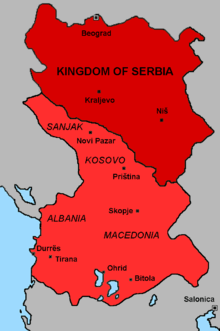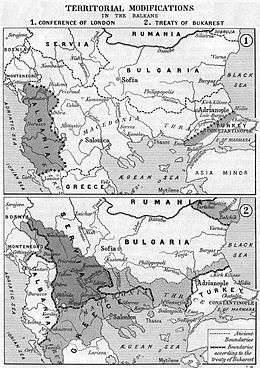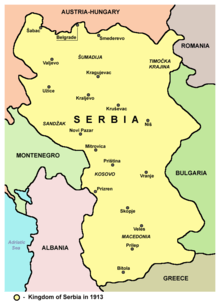Kingdom of Serbia
| Kingdom of Serbia | ||||||||||||
| Краљевина Србија (Serbian) Kraljevina Srbija (Serbian) | ||||||||||||
| ||||||||||||
| ||||||||||||
| Motto С вером у Бога, за Краља и Отаџбину (S verom u Boga, za Kralja i Otadžbinu) "With faith in God, for King and Fatherland" | ||||||||||||
| Anthem Bože pravde (Боже правде) "God of Justice" | ||||||||||||
.svg.png) The Kingdom of Serbia in 1914 | ||||||||||||
| Capital | Belgrade | |||||||||||
| Languages | Serbian | |||||||||||
| Religion | Serbian Orthodoxy | |||||||||||
| Government | Constitutional monarchy | |||||||||||
| King | ||||||||||||
| • | 1882–1889 | Milan I | ||||||||||
| • | 1889–1903 | Alexander I | ||||||||||
| • | 1903–1918 | Peter I | ||||||||||
| Prime Minister | ||||||||||||
| • | 1882–1883 | Milan Piroćanac (first) | ||||||||||
| • | 1912–1918 | Nikola Pašić (last) | ||||||||||
| Legislature | National Assembly | |||||||||||
| Historical era | New Imperialism / WWI | |||||||||||
| • | Proclamation of Kingdom | 6 March 1882 | ||||||||||
| • | Serbo-Bulgarian War | 14 November 1885 | ||||||||||
| • | Balkan Wars | 1912–1913 | ||||||||||
| • | Treaty of London | 30 May 1913 | ||||||||||
| • | Serbian Campaign | 1914–1918 | ||||||||||
| • | Creation of Kingdom of Serbs, Croats and Slovenes | 1 December 1918 | ||||||||||
| Currency | Serbian dinar | |||||||||||
| ||||||||||||
| Today part of | | |||||||||||
The Kingdom of Serbia (Serbian: Краљевина Србија / Kraljevina Srbija), often rendered as Servia in English sources during the time of its existence, was created when Prince Milan I of Serbia, ruler of the Principality of Serbia, was crowned king in 1882.
Since 1817 the Principality was ruled by the Obrenović dynasty (replaced by the Karađorđević dynasty for a short time). The Principality, suzerainty of the Ottoman Empire, de facto achieved full independence when the last Ottoman troops left Belgrade in 1867. The Congress of Berlin in 1878 recognized the formal independence of the Principality of Serbia. In 1882 King Milan I proclaimed a kingdom and maintained a foreign policy friendly to Austria-Hungary.
Between 1912 and 1913 Serbia greatly enlarged its territory through engagement in the First and Second Balkan Wars - Sandžak-Raška, Kosovo Vilayet and Vardar Macedonia were annexed. As outcome of the World War One in 1918 it united with Vojvodina and Kingdom of Montenegro. Towards the end of 1918, Serbia joined with the newly created State of Slovenes, Croats and Serbs to form the new Kingdom of Serbs, Croats and Slovenes (later known as Kingdom of Yugoslavia) under the continued rule of the Serbian Karađorđević dynasty.
Principality of Serbia

The Principality of Serbia was a state in the Balkans that came into existence as a result of the Serbian revolution which lasted between 1804 and 1817. Despite brutal oppression and retaliation by the Ottoman authorities, the revolutionary leaders, first Karađorđe and then Miloš Obrenović, succeeded in their goal to liberate Serbia after centuries of Turkish rule.
At first, the principality included only the territory of the former Pashaluk of Belgrade, but in 1831-1833 it expanded to the east, south, and west. In 1867 the Ottoman army left the Principality, securing its de facto independence.[1] Serbia expanded further to the south-east in 1878, when it won full international recognition at the Congress of Berlin. In 1882 it was raised to the level of the Kingdom of Serbia.
Serbo-Bulgarian War, 1885
The Serbo-Bulgarian War erupted on November 14, 1885 and lasted until November 28 of the same year. The war ended in defeat for Serbia, as it had failed to capture the Slivnitsa region which it had set out to achieve. Bulgarians successfully repelled the Serbs after the decisive victory at the Battle of Slivnitsa and advanced into Serbian territory taking Pirot and clearing the way to Niš.
When Austria-Hungary declared that it would join the war on the side of Serbia, Bulgaria withdrew from Serbia leaving the Serbo-Bulgarian border precisely where it had been prior to the war. The peace treaty was signed on February 19, 1886 in Bucharest. As a result of the war, European powers acknowledged the act of Unification of Bulgaria which happened on September 6, 1885.
Politics
In 1888 People's Radical Party led by Sava Grujić and Nikola Pašić came to power and a new constitution, based on the liberal Constitution of Belgium was introduced. The lost war and the Radical Party's total electoral victory were some of the reasons why King Milan I abdicated in 1889. His son Alexander I assumed the throne in 1893 and in 1894 dismissed the constitution.
May Coup, 1903
King Alexander I of Serbia and his unpopular wife Queen Draga, were assassinated inside the Royal Palace in Belgrade on the night of 28–29 May 1903. Other representatives of the Obrenović family were shot as well. This act resulted in the extinction of the House of Obrenović which had been ruling Serbia since 1817.
Peter I

After the May Coup Serbian Skupština invited Peter Karadjorjević to assume the Serbian crown as Peter I of Serbia. A constitutional monarchy was created with the military Black Hand society operating behind the scenes. The traditionally good relations with the Austria-Hungary ended, as the new dynasty relied on the support of the Russian Empire and closer cooperation with Kingdom of Bulgaria.
On April 1904 the Friendship treaty and on June 1905 the customs union with Bulgaria were signed. In response Austria-Hungary imposed a Tariff War (Pig war) of 1906-1909. After the 1906 elections People's Radical Party came to power. In 1908 Austria-Hungary annexed Bosnia, where Serbia had hoped to expand its territory.
Bosnian Crisis
The Bosnian Crisis of 1908–1909 (also referred to as the Annexation crisis) erupted into public view when on October 5, 1908, Kingdom of Bulgaria declared its complete independence from Ottoman Empire and on October 6, 1908, when Austria-Hungary announced the annexation of Bosnia and Herzegovina, which was populated mainly by South Slavs (Serbs and Croats).
Russia, the Ottoman Empire, Britain, Kingdom of Italy, Serbia, Principality of Montenegro, German Empire and France took an interest in these events. In April 1909, the 1878 Treaty of Berlin was amended to accept the new status quo and bringing the crisis to an end. The crisis permanently damaged relations between Austria-Hungary on the one hand and Russia and Serbia on the other. The annexation and reactions to the annexation were some of the contributing causes of World War I.
The Ten Years War
Between 1912 and 1922 Serbia was involved in a number of wars that brought it to the brink of total destruction and ended with renewed greatness. Victorious in two Balkan Wars, it gained significant territorial areas of the Central Balkans and almost doubled its territory.
Balkan Wars and expansion


Negotiations between Russia, Serbia and Bulgaria led to the Serbian-Bulgarian Treaty of Alliance of March 1912 which aimed to conquer and to divode the Ottoman held Macedonia. On May Serbian-Greek alliance was reached and in October 1912 Serbia-Montenegro alliance was signed.[2]
After the war started, Serbia, together with Montenegro conquered Pristina and Novi Pazar. At the Battle of Kumanovo Serbians defeated Ottoman army and proceeded to conquer Skopje and the whole of Kosovo vilayet. The region of Metohija (known as the Dukagjini Valley to ethnic-Albanians) was taken by Montenegro. At Bitola and Ohrid Serbian army units established contact with the Greek army.
Populations of ethnic Serbs and Albanians tended to shift following territorial conquests. As a result of the multi-ethnic composition of Kosovo, the new administrations provoked a mixed response from the local population. While Albanians did not welcome Serbian rule,[3] the non-Albanian population (largely Serbs but other Southern Slavs too) considered this a liberation.
On November 29, 1913 the Drač County of the Kingdom of Serbia was established on the part of the territory of Albania captured from the Ottoman Empire during the First Balkan War. Serbian Drač County had four districts (Serbian: срез): Drač (Durrës), Lješ (Lezhë), Elbasan and Tirana.[4][5]
After the First Balkan War of 1912, Kosovo and north-western Macedonia was internationally recognised as a part of Serbia[6] and northern Metohija as a part of Montenegro at the Treaty of London of May 1913.[7]
The old disagreements regarding the territory of Macedonia among the members of the Balkan League and primarily Serbia and Bulgaria, led to the Second Balkan War. Here, Serbia and Greece fought against Bulgaria in 1913.
The final borders were ratified at the Treaty of Bucharest of 1913. Serbia came to control the land which became known as Vardar Macedonia, and today stands independent as the Republic of Macedonia but land-locked Serbia was prevented from gaining access to Adriatic Sea by the newly established Principality of Albania, while many ethnic Albanians remained within the new Serbian borders. As the result of these wars, Serbia's population increased from 2.9 million to 4.5 million and territory increased by 81%.
In a report to Rome, Lazër Mjeda, Archbishop of Skopje, estimated that 25,000 Albanians were killed by Serbian forces during and after the conflict.[8]
Assassination in Sarajevo

The assassination of Archduke Franz Ferdinand of Austria on 28 June 1914 in Sarajevo (then part of the Austria-Hungary) brought the tensions between Austria-Hungary and Serbia to a head. Behind the assassination in Sarajevo was the secret Serbian officers organization Black Hand.[9] The assassins were supported by an "underground railroad" of Serbian civilians and military officers that provided transportation and hid them; members of the Serbian military that trained them, encouraged them, and provided weapons, maps, and other information. After the assassination, the conspirators were arrested in Bosnia-Herzegovina and tried in Sarajevo in October 1914.
The political objective of the assassination was to break the southern Slav provinces off from the Austro-Hungarian Empire. Assassination of Archduke Franz Ferdinand triggered a chain of international events that embroiled Russia and the major European powers in the conflict.
World War I
On July 28, 1914 Austria-Hungary declared the war against Serbia.
In 1915 Serbia was occupied by foreign troops after a combined invasion by Austro-Hungarian, German, and Bulgarian troops. The 135 000 soldiers of the Serbian army retreated through Albania and were evacuated to the Greek island of Corfu, and in spring 1916 they became part of a newly formed Salonika front. In 1916 Kingdom of Montenegro was conquered by Austria-Hungary.
At the end of the war and collapse of Austria-Hungary, Serbia went through radical changes within days. On November 28, 1918, it absorbed the Kingdom of Montenegro at the Podgorica Assembly.[10][11]
On December 1, 1918 Serbia united with the newly created State of Serbs, Croats and Slovenes to form a new Southern Slav state, the Kingdom of Serbs, Croats and Slovenes.[12] The new country continued to be ruled by the Serbian monarchy when on August 1921 Prince Alexandar I became the King.
Kings
During its existence, the Kingdom was ruled by two dynasties: the House of Obrenović and the House of Karađorđević. King Milan Obrenović ruled from 6 March 1882 to 6 March 1889, when he abdicated the throne. He was succeeded by his son, Aleksandar Obrenović, who ruled from 6 March 1889 to 11 June 1903, when he was killed by a group of officers. The slaughter of the royal couple (the king and Queen Draga) by the Black Hand shocked Europe. This opened the way for the descendants of Karađorđe (Karageorge), regarded by Serbs throughout the Balkans as the man who threw off the Turkish yoke, to return to the throne. Petar Karađorđević was initially reluctant to accept the crown, disgusted as he was by the coup d'état. However, he finally did accept and was the Kingdom's sovereign from 15 June 1903 to 1 December 1918, the day that the Kingdom of Serbs, Croats and Slovenes was proclaimed.
Cities
Part of a series on the |
||||||||||||||||
|---|---|---|---|---|---|---|---|---|---|---|---|---|---|---|---|---|
| History of Serbia | ||||||||||||||||
 | ||||||||||||||||
|
||||||||||||||||
|
||||||||||||||||
|
||||||||||||||||
|
||||||||||||||||
|
||||||||||||||||
|
| ||||||||||||||||
The largest cities in the Kingdom of Serbia were (with population figures from c. 1910–1912):
- Belgrade - 100,000
- Prizren - 60,000
- Bitola - 54,000
- Skopje - 50,000
- Niš - 25,000
- Veles - 24,000
- Priština - 20,000
- Prilep - 20,000
- Kragujevac - 18,500
- Ohrid - 18,000
- Leskovac - 14,300
- Tetovo - 14,000
- Požarevac - 13,600
- Šabac - 12,800
- Mitrovica - 12,000
- Vranje - 10,500
- Pirot - 10,000
Maps
 The Principality of Serbia in 1878.
The Principality of Serbia in 1878. Serbia 1882–1912.
Serbia 1882–1912. Short-lived territorial expansion of Serbia in 1912-1913, following the First Balkan War.
Short-lived territorial expansion of Serbia in 1912-1913, following the First Balkan War. Territorial expansion of Serbia 1913-1915, following the Second Balkan War.
Territorial expansion of Serbia 1913-1915, following the Second Balkan War. Serbia boundaries following Balkan Wars.
Serbia boundaries following Balkan Wars. Serbia in 1918 (27 November - 1 December), following its annexation of Syrmia (24 November), Banat, Bačka and Baranja (25 November) and the Kingdom of Montenegro (27 November).
Serbia in 1918 (27 November - 1 December), following its annexation of Syrmia (24 November), Banat, Bačka and Baranja (25 November) and the Kingdom of Montenegro (27 November).
See also
Notes
| a. | ^ Kosovo is the subject of a territorial dispute between the Republic of Kosovo and the Republic of Serbia. The Republic of Kosovo unilaterally declared independence on 17 February 2008, but Serbia continues to claim it as part of its own sovereign territory. The two governments began to normalise relations in 2013, as part of the Brussels Agreement. Kosovo has received recognition as an independent state from 110 out of 193 United Nations member states. |
References
- ↑ http://globalanalyst.org/uploads/Yugo_ethnic.pdf
- ↑ The Balkans: Revolution, War, and Political Violence Since 1878
- ↑ Malcolm, Noel (26 February 2008). "Is Kosovo Serbia? We ask a historian". The Guardian.
- ↑ Bogdanović, Dimitrije; Radovan Samardžić (1990). Knjiga o Kosovu: razgovori o Kosovu. Književne novine. p. 208. Retrieved August 2, 2011.
На освојеном подручју су одмах успостављене грађанске власти и албанска територија је Де Факто анектирана Србији : 29. новембра је основан драчки округ са четири среза (Драч, Љеш, Елбасан, Тирана)....On conquered territory of Albania was established civil government and territory of Albania was de facto annexed by Serbia: On November 29 was established Durres County with four srez (Durres, Lezha, Elbasan, and Tirana)
- ↑ Petrović, Dragoljub S. (1990). "Heterogenost stanovništva determinanta složenosti rešenja političkog statusa albanskog prostora (Heterogeneity of the population as determinant of the complexity of solving the political status of the Albania)" (in Serbian). pp. 237–271. OCLC 439985244.
Potom, 29. novembra 1912. formiran je Drački okrug u okviru kojeg su srezovi - Drač, Tirana, Elbasan i Lješ. ... On November 29, 1912 the Durres County was established and in it there were established the following districts - Durres, Tirana, Elbasan and Lezhe
- ↑ http://www.zum.de/psm/div/tuerkei/mowat120.php
- ↑ http://www.mtholyoke.edu/acad/intrel/boshtml/bos145.htm
- ↑ https://books.google.se/books?id=Pg-aeA-nUeAC&pg=PA219&redir_esc=y#v=onepage&q&f=35
- ↑ Strachan, Hew (2001) The First World War Volume 1: To Arms (pp. 46). Oxford University Press. Oxford. ISBN 0-19-926191-1
- ↑ Montenegrins' Effort to Prevent Annexation of Their Country to Serbia
- ↑ Serbs wipe out royalist party in Montenegro
- ↑ Richard C Hall, The Balkan Wars 1912-1913
External links
| Wikimedia Commons has media related to Kingdom of Serbia. |
| Timeline of Yugoslav statehood | |||||||||||
|---|---|---|---|---|---|---|---|---|---|---|---|
| Pre-1918 | 1918–1929 | 1929–1945 | 1941–1945 | 1945–1946 | 1946–1963 | 1963–1992 | 1991/1992–2003 | 2003–2006 | 2006–2008 | 2008– | |
| Slovenia | See also Kingdom of Croatia-Slavonia 1868–1918 Kingdom of Dalmatia 1815–1918 Condominium of Bosnia and Herzegovina 1878–1918 |
See also Banat, Bačka and Baranja 1918–1919 Italian province of Zadar 1920–1947 |
Annexed bya Fascist Italy and Nazi Germany |
Democratic Federal Yugoslavia 1945–1946 Federal People's Republic of Yugoslavia 1946–1963 Socialist Federal Republic of Yugoslavia 1963–1992 Consisted of the Socialist Republics of |
Ten-Day War | ||||||
| Dalmatia | Independent State of Croatia 1941–1945 Puppet state of Nazi Germany. Parts annexed by Fascist Italy. Međimurje and Baranja annexed by Hungary. |
Croatian War of Independence | |||||||||
| Slavonia | |||||||||||
| Croatia | |||||||||||
| Bosnia | Bosnian War Consists of the Federation of Bosnia and Herzegovina (1995–present), Republika Srpska (1995–present) and Brčko District (2000–present). | ||||||||||
| Herzegovina | |||||||||||
| Vojvodina | Part of the Délvidék region of Hungary | Autonomous Banatd (part of the German Territory of the Military Commander in Serbia) |
Federal Republic of Yugoslavia | State Union of Serbia and Montenegro | |
Includes the autonomous province of Vojvodina | |||||
| Serbia | Kingdom of Serbia 1882–1918 |
Territory of the Military Commander in Serbia 1941–1944 e | |||||||||
| Kosovo | Part of the Kingdom of Serbia 1912–1918 |
Mostly annexed by Albania 1941–1944 along with western Macedonia and south-eastern Montenegro |
| ||||||||
| Metohija | Kingdom of Montenegro 1910–1918 Metohija controlled by Austria-Hungary 1915–1918 | ||||||||||
| Montenegro | Protectorate of Montenegrof 1941–1944 |
| |||||||||
| Macedonia | Part of the Kingdom of Serbia 1912–1918 |
Annexed by the Kingdom of Bulgaria 1941–1944 |
| ||||||||
|
| ||||||||||
.svg.png)
.svg.png)